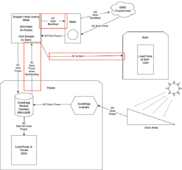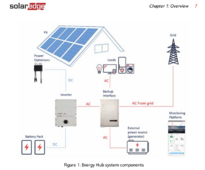Hi,
I have a panel at my meter with a 200A breaker that is the main disconnect for my house and also for a 100A feed to my barn. I'll be bringing DC from my array into my house basement. The 200A load panel for my house is also in the basement. The 200A load panel in the basement is fed by the 200A panel at the meter. See attached diagram.
I'm planning to use the SolarEdge Backup Interface which creates a microgrid when the grid is down, allowing the grid-tied inverters to function when the grid is down. The optimizers and inverters are also SolarEdge. The Backup Interface is supposed to be installed with the Grid and Inverters as inputs and the load panel wired to the output (see attached SolarEdge graphic). When there is an excess of solar power, the Backup Interface backfeeds to the grid.
My question is that when I am backfeeding to the grid, which would also be backfeeding my 100A feed to my barn, do I need to be concerned about the backfeed power quality to loads in my barn? For example, voltage or frequency variations? If this is a concern, is there anything I can do about it?
I have a panel at my meter with a 200A breaker that is the main disconnect for my house and also for a 100A feed to my barn. I'll be bringing DC from my array into my house basement. The 200A load panel for my house is also in the basement. The 200A load panel in the basement is fed by the 200A panel at the meter. See attached diagram.
I'm planning to use the SolarEdge Backup Interface which creates a microgrid when the grid is down, allowing the grid-tied inverters to function when the grid is down. The optimizers and inverters are also SolarEdge. The Backup Interface is supposed to be installed with the Grid and Inverters as inputs and the load panel wired to the output (see attached SolarEdge graphic). When there is an excess of solar power, the Backup Interface backfeeds to the grid.
My question is that when I am backfeeding to the grid, which would also be backfeeding my 100A feed to my barn, do I need to be concerned about the backfeed power quality to loads in my barn? For example, voltage or frequency variations? If this is a concern, is there anything I can do about it?




